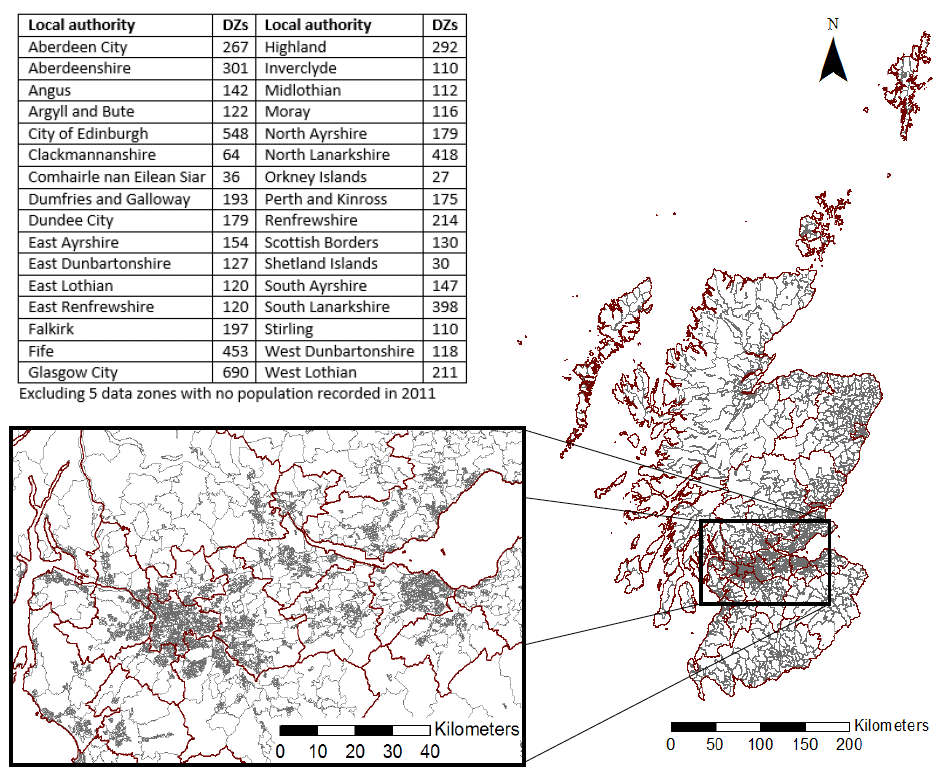Mapping Flood Disadvantage in Scotland 2015: Methodology Report
This report describes the methods applied in developing the flood disadvantage dataset for the project Mapping Flood Disadvantage in Scotland 2015.
3. Spatial units and datasets used
The data zones 2001 were applied as the spatial units in this assessment. Data zones are the small area geography used by the Scottish Government to make statistics available (NRS 2013). They are compact areas each of around 500-1,000 residents[1] that are nested within local authority boundaries, and contain households with similar social characteristics (SG ATOM Feed, 2014). There are 6505 data zones in Scotland (Figure 2)[2].
Data zones were chosen as the spatial unit for analysis because most data used in the vulnerability assessment is reported at that scale (for example: census 2011; SIMD; Scottish Neighbourhood Statistics data). If a finer scale was used (census Output Areas, for example), data for some of the indicators would not be available or would need to be derived from larger units. Using data zones has helped to limit the uncertainty associated with re-scaling the data from one type of territorial unit to another.
Further, for confidentiality issues, census data reported at fine-scale spatial units are subject to statistical disclosure control, e.g. record swapping; therefore, for the smaller units, the effects of trade-offs between the data utility and the risk of disclosing confidential information may be more pronounced. Data zones are large enough areas to allow statistics to be presented accurately without fear of disclosure and yet small enough that they can be used to represent communities.
One limitation of Data zones is their large variability in area (Figure 2), due to the units being defined based upon population numbers. The physical size of units (e.g. in rural areas) and/or their internal variability will mean that not all socially vulnerable places may be accurately identified. The variability in size also causes some challenges for the presentation and interpretation of the data. For example, results for the smallest data zones (those with high population density) are not legible when viewing the whole of Scotland and visually comparing areas with large differences in size is more difficult. A recommended approach to address the presentation of the maps is to display them in an online portal allowing the users to view the data at a preferred scale[3].
An alternative approach would have been to use abstract spatial units that are uniform in size, such as 1km2 grid cells which were used in the National Flood Risk Assessment (SEPA, 2011). Whilst this would have been justified in a situation where a large proportion of data was not reported for any specific spatial unit (e.g. NFRA is reporting on issues such as location of infrastructure), in the context of the data relating to population, the census-derived units were seen as the best option. Further, they are recognised by local authorities as they are used in resource allocation and planning services (NRS, 2013).
The data zones were initially developed based on census 2001 data. For the consistency of reporting, ONS has used the same data zones to report census 2011 findings. Between 2001 and 2011 there was little change in the population of most data zones. However, some data zones experienced greater change (769 data zones increasing by 20% or more and 147 data zones decreasing by 20 % or more; NRS, 2013). The changes in the distribution of the population, in particular associated with urban regeneration and demolition of housing estates in Edinburgh and Glasgow resulted in five data zones not having any population associated with them in 2011.[4] For these data zones the census data was not reported and so they were excluded from the analysis and are presented as blank on maps.
Figure 2. Data zones in Scotland. Ordnance Survey data © Crown Copyright and database right 2015

In addition, the analysis of the OS Addressbase 2015 has indicated that further changes in the distribution of population meant that five data zones (including two of those identified as having no population in 2011) were recorded as having no residential addresses associated with them in 2015[5]. This means that these data zones had zero residential addresses at risk of flooding and therefore were treated as not exposed to flooding and feature on the flood disadvantage maps as blank. The issue of an absence of population affects only 8 out of 6505 data zones, which is around 0.1% of the total number of data zones.
Data sources used to collate the information on the personal, social and environmental factors affecting social vulnerability to flooding are listed in Table 1. The flood extents (Flood Hazard Maps) obtained from SEPA and used to assess the flood disadvantage are listed in section 5.
Table 1. Data sources used in the assessment of social vulnerability to flooding
| Dataset | Date | Source |
|---|---|---|
| Scottish census | 2011 | http://www.scotlandscensus.gov.uk/ |
| Scottish census | 2001 | Scottish Government |
| Land Cover Map 2007 | 2007 | Centre for Ecology and Hydrology (Morton et al., 2011) |
| Postcode Point Data | 2014 | Ordnance Survey |
| OS Addressbase | 2015 | Ordnance Survey |
| OS MasterMap Integrated Transport Network | 2015 | Ordnance Survey |
| Scottish Charity Register | 2015 | OSCR - Scottish Charity Regulator, http://www.oscr.org.uk/charities |
| Flood Warning Target Areas | 2014 | SEPA |
| Historic Flood Data | 2014 | SEPA |
| Flood Hazard Maps | 2015 (version 1.1 released in March 2015) | SEPA |
| Scottish Neighbourhood Statistics | varied | http://www.sns.gov.uk/ |
Contact
Email: Carol Brown
There is a problem
Thanks for your feedback